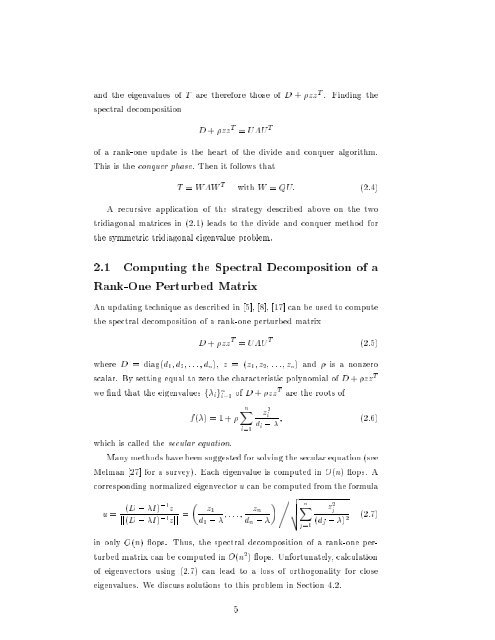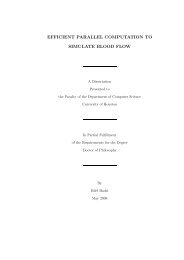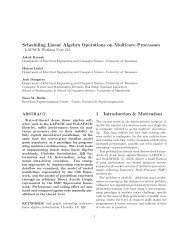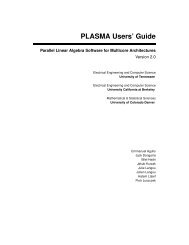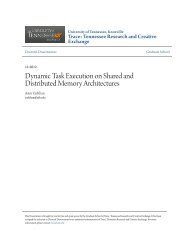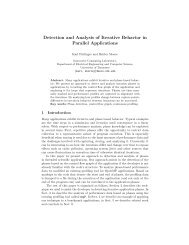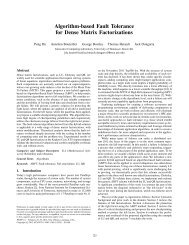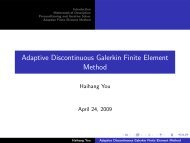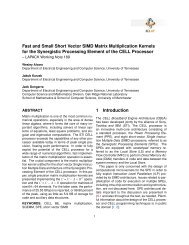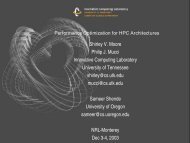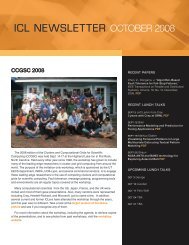Parallelizing the Divide and Conquer Algorithm - Innovative ...
Parallelizing the Divide and Conquer Algorithm - Innovative ...
Parallelizing the Divide and Conquer Algorithm - Innovative ...
You also want an ePaper? Increase the reach of your titles
YUMPU automatically turns print PDFs into web optimized ePapers that Google loves.
<strong>and</strong> <strong>the</strong> eigenvalues of T are <strong>the</strong>refore those of D + zz T .<br />
spectral decomposition<br />
Finding <strong>the</strong><br />
D + zz T = UU T<br />
of a rank-one update is <strong>the</strong> heart of <strong>the</strong> divide <strong>and</strong> conquer algorithm.<br />
This is <strong>the</strong> conquer phase. Then it follows that<br />
T = WW T with W = QU: (2.4)<br />
A recursive application of <strong>the</strong> strategy described above on <strong>the</strong> two<br />
tridiagonal matrices in (2.1) leads to <strong>the</strong> divide <strong>and</strong> conquer method for<br />
<strong>the</strong> symmetric tridiagonal eigenvalue problem.<br />
2.1 Computing <strong>the</strong> Spectral Decomposition of a<br />
Rank-One Perturbed Matrix<br />
An updating technique as described in [5], [8], [17] can be used to compute<br />
<strong>the</strong> spectral decomposition of a rank-one perturbed matrix<br />
D + zz T = UU T (2.5)<br />
where D = diag(d1;d2;:::;d n ), z = (z1;z2;:::;z n ) <strong>and</strong> is a nonzero<br />
scalar. By setting equal to zero <strong>the</strong> characteristic polynomial of D + zz T<br />
we nd that <strong>the</strong> eigenvalues f i g n i=1 of D + zzT are <strong>the</strong> roots of<br />
nX<br />
f() =1+<br />
i=1<br />
which is called <strong>the</strong> secular equation.<br />
z 2 i<br />
d i , ; (2.6)<br />
Many methods have been suggested for solving <strong>the</strong> secular equation (see<br />
Melman [27] for a survey). Each eigenvalue is computed in O(n) ops. A<br />
corresponding normalized eigenvector u can be computed from <strong>the</strong> formula<br />
u =<br />
(D , I),1 z z<br />
jj(D , I) ,1 zjj = 1<br />
d1 , ;:::; z n<br />
d n ,<br />
,v uut nX<br />
j=1<br />
z 2 j<br />
(d j , ) 2 (2.7)<br />
in only O(n) ops. Thus, <strong>the</strong> spectral decomposition of a rank-one perturbed<br />
matrix can be computed in O(n 2 ) ops. Unfortunately, calculation<br />
of eigenvectors using (2.7) can lead to a loss of orthogonality for close<br />
eigenvalues. We discuss solutions to this problem in Section 4.2.<br />
5


